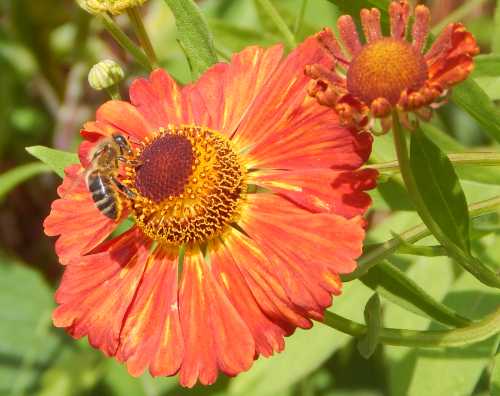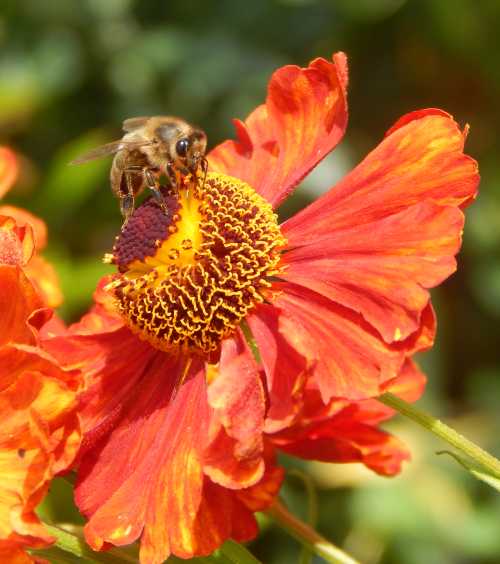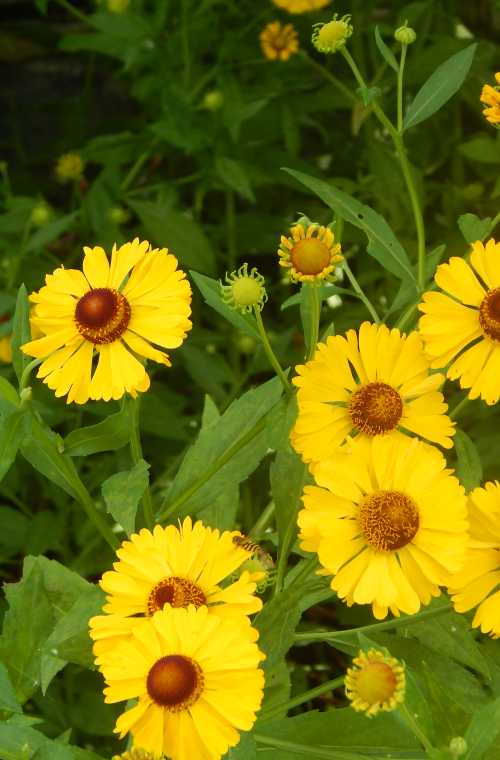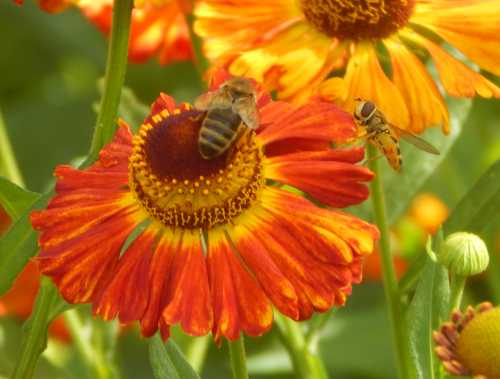Bees And Pollinators Love Sneezeweed
Updated: 30th April 2021
Bringing a wonderful splash of warm golden orange, copper
and yellow sunshine shades to the flower border, sneezeweed graces the garden
with its lovely, happy blooms from mid summer through autumn, and better still, bees and other
pollinators love this cheerful flowering plant.
Sneezeweed is a member of the Asteracea family and also one of the 'coneflowers' along with Echinacea and Rudbeckia. Like so many
sharing the same family (Asteracea), if you add it to your border, you’ll stand a good chance of
attracting honey bees, bumble bees and a range of solitary bee species to your
garden, not to mention butterflies and hoverflies.
Better still, sneezeweed comes into its glory through the last weeks of summer, to help late emerging bee species, as well as helping honey bees stock up in preparation for the cooler period ahead.
 Sneezeweed is attractive to bees. It is a member of the Asteracea family and also one of the 'coneflowers'.
Sneezeweed is attractive to bees. It is a member of the Asteracea family and also one of the 'coneflowers'.
Sometimes I think of sneezeweed almost as an alternative to the sunflower: if you want a flower with all the cheer of a sunflower, but with smaller flower heads, all whilst feeding the bees at the same time, sneezeweed is a great choice.
Compact varieties are available, but I especially like the very tall ones -
they catch the eye even at the back of the flower border with those lovely vibrant flower heads.
 These happy blooms need a sunny spot.
These happy blooms need a sunny spot.
Sneezeweed is available as a perennial, biennial or annual. It is easy to grow from seed, but do
be cautious if handling seeds as they may irritate the skin.
Sneezeweed needs a sunny spot, and although it can thrive in an exposed position, you may need to support tall stems. You can dead head the flowers to prolong the flowering season.
 Hover fly on sneezeweed (lower middle part of photograph).
Hover fly on sneezeweed (lower middle part of photograph).
Tip - sharing pollinator plants with friends, helps bees
Select a perennial variety, and divide the clumps in autumn to quickly establish new patches – or even donate a clump to a neighbour or friend to help get as many people as possible on board with including flowers for bees in their gardens (it works – I have given lamb’s ear and linaria to nearby friends and neighbours to help encourage and expand the territory of wool carder bees in my area – likewise, a neighbour gave pulmonaria to me, which attracts hairy footed flower bees to my garden).
 Honey bee and hover fly share a sneezeweed flower.
Honey bee and hover fly share a sneezeweed flower.It is largely pest free, although it can be troubled by a
bit of leaf spot.
Which
varieties of sneezeweed should I grow for bees?
There are lovely sneezeweeds to choose from that will be appreciated by pollinators in your garden. Here are a few varieties for you to consider (check the height for your particular flower border requirements).
- Helenium autumnale - 'Sunshine Hybrids'
- Helenium 'Chelsey' - sneezeweed 'Chelsey'
- Helenium 'Ring of Fire' - sneezeweed 'Ring of Fire'
- Helenium autumnale 'Bandera' - sneezeweed 'Bandera'
-
Helenium 'The Bishop' - sneezeweed 'The Bishop'
- Helenium 'Butterpat' - sneezeweed 'Butterpat'
- Helenium 'Sahin's Early Flowerer' - sneezeweed 'Sahin's
Early Flowerer'
-
Helenium 'Coppelia' - sneezeweed 'Coppelia'
- Helenium 'Summer Circle' - sneezeweed 'Summer Circle'
- Helenium 'Karneol' - sneezeweed 'Karneol'
More about plants and bees....
- 5 Reasons To Add Wildflowers To Your Lawn Or Flower Border 5 Reasons To Add Wildflowers To Your Lawn Or Flower Border: helping bees, butterflies and other pollinators in your garden with wonderful wildflowers
- Do Bees Pollinate Tomatoes? Do Bees Pollinate Tomatoes? Yes! Bumblebees do - more information here, plus how do you know if bees have pollinated your tomatoes?
- Pulmonaria Officinalis - A Wonderful Early Flowering Plant For Bees Pulmonaria Officinalis - A Wonderful Early Flowering Plant For Bees - attracts bumblebees and hairy footed flower bees and is easy to grow